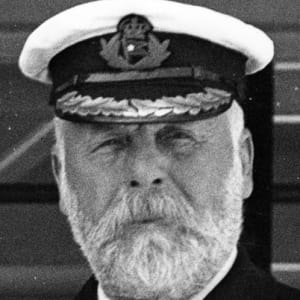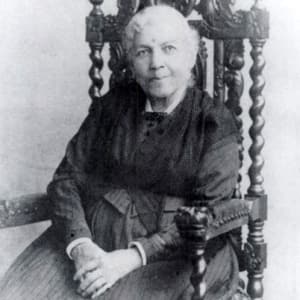
Edward J. Smith
Captain Edward J. Smith played a role in one of the most famous disasters at sea in history, the sinking of the Titanic in 1912.
Synopsis
Born on January 27, 1850, in Hanley, Staffordshire, England, Captain Edward J. Smith, captain of the luxury vessel Titanic, played a role in one of the most famous disasters at sea in history when it sank in 1912.
A Sailor's Life
Captain of the Titanic. Born on January 27, 1850, in Hanley, Staffordshire, England. Captain Edward J. Smith played a role in one of the most famous disasters at sea in history, the sinking of the Titanic in 1912. The son of a potter and later a grocer, he attended a school in Etruria, which was supported by the Wedgwood pottery works. Smith stopped going to school around the age of 12. Beginning his life on the sea as a teenager, he signed on to the crew of the Senator Weber in 1867.
For years, Smith rose up the ranks and qualifications, earning certificates as a second mate in 1871, a first mate in 1873, and a master in 1875. The first vessel he commanded was the Lizzie Fennell, a 1,000-ton ship that moved goods to and from South America. Smith made the leap to passenger vessels in 1880 when he went to work for the White Star Line. By 1885, he was the first officer of the Republic. Two years later, Smith married Eleanor Pennington. The couple welcomed their only child, Helen, in 1902.
Eight years later, Smith took his first command of a passenger ship, the Baltic. He went on to serve as the captain of several other vessels in the White Star Line. From 1895 to 1904, Smith commanded the Majestic. He also served in the British Royal Navy during the Boer War in South Africa.
In 1902, the White Star Line was bought by the International Mercantile Marine (IMM) Company in a deal financed by famed banker J. P. Morgan. A new Baltic was added to the White Star Line fleet in 1904 with Smith as its captain. At 23,000 tons, the Baltic was one of the largest vessels at the time. His next ship, the Adriatic, was even larger. By this time, Smith was held in high esteem by his company and was well known and well regarded among travelers on the North Atlantic route between the United States and Europe.
Captain of the Titanic
The White Star Line planned to add even grander ships to its fleet. To compete with the Lusitania and Mauretania owned by Cunard, the company announced it was building two new ocean liners in 1907. (The order for the Gigantic was made later and was then renamed Britannic after the Titanic disaster) The first of the two vessels, the Olympic, was launched in 1910 with Smith in command. His ship was damaged in September 1911 when a British Royal Navy cruiser crashed into its side.
In 1912, Smith became the captain for the Titanic. He was in Belfast on April 2, 1912, for the vessel’s first sea trials. Two days later, the ship docked in Southampton and was prepared for its maiden voyage across the North Atlantic. It was heralded as one of the biggest and most luxurious ships of the time.
On April 10, 1912, the Titanic left Southampton and stopped in Cherbourg, France, to pick up more passengers and mail. It made one stop in Queenstown, Ireland, the next day before setting out into the Atlantic. There the ship took on more passengers as well as mail to be delivered to the United States. In all, there were more than 2,200 people aboard the ship as it made its way across the ocean.
Trouble at Sea
The first few days seemed to pass without incident. On the morning of April 14, the Titanic received a warning about ice in its path from the Caronia. Smith reportedly posted this message on the bridge. He then led the religious service for the first class passengers. Another message about dangerous ice came from the Baltic in the early afternoon. Smith showed this message to Joseph Bruce Ismay, the chairman of the White Star Line and president of IMM. Ismay held on to this note until later that evening.
The earlier warning from the Baltic is posted on the ship’s bridge around 7 p.m. A half an hour later, Smith attended a private party held by Mr. and Mrs. George Dunton Widener in the ship's a la carte restaurant. Other guests included railroad executive John B. Thayer and Major Archibald Butt. Around this time, another ice warning from the nearby Californian was sent to another ship in its fleet; this transmission was reportedly overheard by the Titanic crew.
After the dinner party, Smith met with his second officer Charles Lightoller on the bridge. Not long after their conversation ended, Smith turned in for the night. Swamped with telegraphic messages for passengers, the operators on the Titanic put aside a warning about icebergs from the Mesaba. A warning transmission from the Californian to the Titanic was also cut off by operators.
Around 11:40 p.m., a crew member spotted an iceberg in the path of the Titanic, but the crew was unable to move away in time. The ship scraped against the iceberg and suffered damage to its forward area. Several holes have been made in the ship’s side, allowing sea water to begin rushing in. Soon after the collision, Smith went to the bridge and worked on assessing the situation. He soon learned that the ship was on its way down and ordered that the crew to prepare the lifeboats. The first distress call went out after midnight.
Death at Sea
Unprepared for such an event, the Titanic did not have enough lifeboats to carry all of its passengers to safety. Smith tried to manage the situation the best that he could, helping with the loading of the boats and managing the transmission of distress calls. He was last seen headed for the bridge.
After 2 a.m. the next morning, the Titanic fully slipped into the dark cold waters of the North Atlantic, taking its captain with it. Several stories emerged about how his life ended. There were reports that he had shot himself on the bridge. Another had him in the water, swimming with an infant in tow and putting the child on a lifeboat before slipping beneath the water. It is commonly held, however, that Smith followed the marine tradition of remaining aboard his doomed vessel.
There were several investigations into the Titanic disaster in the United States and England. With all of the warnings, many wondered why Smith chose not to slow down or turn south in response to the threat of icebergs. He was not found to be responsible for the shipwreck.




